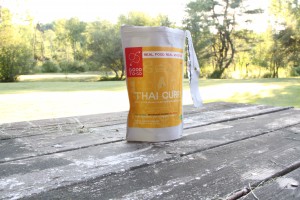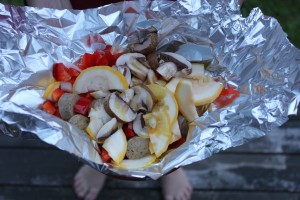Carrying your kitchen: weighing the options for backcountry dining
VERMONT — Going camping and trying to figure out what to bring for food for a multiple-day trip? Here’s a few ideas for adventurers heading out on hikes, kayak tours or even car-camping throughout the Green Mountains, White Mountains or Adirondacks.
If you’re planning on camping with your car close-by, settle for nothing less than a large, two-burner camp stove from companies like Coleman or Primus. Camping here in New England also offers the opportunity to cook over open fires, an activity that is banned in most areas of the West because of high fire danger. Many area sites include fire rings with large, foldable grates you can cook on.
Otherwise, if you’re moving light and fast through the backcountry, your culinary experience will be more limited, but you don’t have to sacrifice variety and spice. Your ability to have hot meals will be determined by your ability to boil water quickly. To that end, backpacking stoves have advanced a long way in recent years, with models from Jetboil and MSR that can boil water in two and four minutes, respectively.
So without going through the very basics, here are a few lightweight options. Some are
Breakfast:
There’s a reason it’s called the most important meal of the day; a good breakfast will give you energy to go for hours. Here are a few suggestions:
Cereal burritos
Here’s a bowl-free and spoon-free way to enjoy your cereal. Spread one side of a tortilla with peanut butter and add your favorite cereal and a sliced banana. Roll it or fold it in half and cut it into sections. It’s a tasty and filling option that you can eat on the go or sit and enjoy.
Citrus rice
Forget oatmeal; here’s a new option for a hot breakfast. At home combine ¼ cup instant rice, 1 tablespoon dried cranberries, ½ teaspoon ground cinnimon, 1 teaspoon citrus powder, 1 tablespoon powdered milk, and 1 teaspoon brown sugar in a plastic bag. At camp, pour mix into a pan and add enough boiling water and let stand until the rice is tender.
Breakfast omelets
With the right tools and preparation, eggs are easier to manage than you might expect. Crack your eggs before you leave and store them in a screw-top plastic container (like an old peanut butter jar). You can add your seasoning, chopped veggies or bacon into the jar for an omelet, or they can be scrambled or poached.
Lunch
After a full morning, your lunch is going to give you the energy to keep going. Unless you have lots of time, you’re probably not going to fire up the stove. If you want to keep moving, consider the array of trail mixes, energy bars and gels that are available from companies like Luna Bar, Cliff Bar, Powerbar and all the other major “bars” out there.
A number of attractive recipes exist for trail mixes with flavors running from sweet and salty to savory. Possible ingredients include the usual suspects, but with some imagination, you can mix combinations of nuts, seeds, sweets and grains for a winning combination that you can eat all day.
For an alternate midday option consider a ploughman’s lunch with pepperoni, cheese and crackers. The combined cost of ingredients should be under ten dollars and will supply you with enough food to share with a friend. This pairs particularly well with the number of dried fruit options that are available.
Dinner
It’s been a long day and the last meal in the twilight hours is an opportunity to provide your body with the nutrients it needs to repair stressed muscles and recharge its energy supplies. If you’re settled into a camp or a shelter, this is when you can be a little more indulgent with the time it takes to prepare and cook your meal. In many recipes, the mixing and chopping can be done at home and stored in Ziploc bags before you reach the campsite.
Speaking of camp meals

Since the advent of dehydrated foods, the array of meals in compact envelopes has exploded. If you can name a meal it’s probably available in a meal that satisfies astronauts and campers alike. Traditionally, meals in pouches are more expensive than preparing your meals yourself and they also pack a serious dose of sodium. That said, these options can cook in as quickly as eight minutes.
Jennifer Scism, an accomplished chef who previously co-owned a successful restaurant in New York City and co-owner of a new company Good to Go, based in Kittery, Me., sent Vermont Sports a few of her latest creations, including penne pasta with marinara sauce, smoked three bean chili, herbed mushroom risotto and Thai curry.
Scism has been able to dial down the high sodium found in other camp meals and traded it for a slightly longer cook time. Preparation for her meals is spent entirely boiling one and a half cups of water and adding an accompanying seasoning packet. Pour the boiling water into the pouch, seal it and wait 20 minutes. For a meal in a foil pouch, 20 minutes is a long time to sit and wait, but consider it time to pitch a tent, chart your course for tomorrow or watch a sunset. It’s worth the wait, as it’s one of the better dehydrated packets we’ve ever sampled.
Chili Mac & Cheese with bacon
This option takes your average box of macaroni and cheese and makes it more interesting with added protein from dehydrated refried bean flakes and chili seasoning. Bring 2 cups water to a boil and add a half pound pasta to boiling water, and cook until al dente, about 10 minutes. Strain off about half the water from the pasta, saving the remaining water. Add the and dehydrated cheese sauce to the pasta pot. Mix in half cup of water, and stir.
Check after 2 minutes. If still too thick, add more water. Let sit for about 5 more minutes until an even sauce has formed and the pasta is fully cooked. Add the bacon bits and dig in.
Tin foil cooking

If you’re in an area where fires are permitted, here’s an option for a hot and low-mess meal. Start by thinly slicing sausage, peppers and onions and placing them in a square sheet of tin foil (eight to twelve inches will do). Add canola or olive oil and your choice of seasonings, fold tightly into an envelope and shake vigorously. Place the folded envelope in the hot coals. Feel free to poke or flip with a stick to provide even cooking. Carefully peel open the foil to check the progress. Smell good? Then it’s probably done.
Bread pudding
This dessert recipe requires mixing ingredients separately at home before you leave. It’s also a good experiment in cooking with zip-top plastic bags.
In one bag, combine 4 slices sandwich bread sliced into cubes and tossed with 3 tablespoons of melted butter. Add ¼ cup raisins, a healthy pinch of nutmeg, ½ teaspoon of cinnamon, ¼ teaspoon of salt, and 1/3 cup of sugar. In a separate bag, combine one egg and a third cup powdered milk. Add a half-cup of water to the milk/egg bag and work to a thick paste. Pour this into the bag with sliced bread, mix well and double-bag. Boil in water for 5 minutes.
